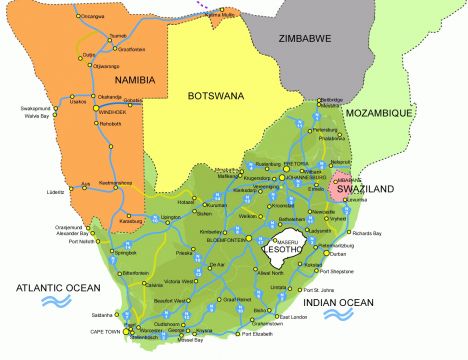For solar companies, journalists, and PR people, an event like last week's Solar Power International is a Kabuki theater of product announcement embargoes -- and spin. Aside from the SolarWorld consortium module dumping complaint, there weren't too many surprises in Dallas this year.
But occasionally, one runs into a curious story a little off the beaten path.
Not a lot of details here -- but a source familiar with the project and member of the AfricaEnergy Corporation team (along with solar pioneer Jigar Shah) and its parent company, Strategic Services International Energy Solutions (SSIES), wants to build 1,000 megawatts of solar power in Namibia (in southwestern Africa). The utility-scale solar would be built in a phased implementation.
Namibia is a big, sparsely populated nation with more than 300 sunny days per year and a relatively stable government. There are about 2.1 million Namibians and the economy is fueled by natural resource mining. Electricity is expensive in the country, with a cost of about $0.35 per kilowatt-hour.
Electricity prices range from about $0.13 per kilowatt-hour to $0.30 per kilowatt-hour according to this document. http://www.ecb.org.na/pdf/tariff/2011/CENORED2011.pdf
According to the source, SSIES has signed a PPA for 500 megawatts of power with NamPower, the Namibian utility. There is a potential for an additional 500 megawatts.
NamPower is a small, profitable utility. Power is currently generated from coal and hydropower and energy is imported from South Africa and Botswana. Power load is expected to increase because of a port development. The development team envisions Namibia becoming a net exporter of energy.
Our source claims that the PPA is signed and that there are 5,000 acres set aside for the project. The SSIES team was at Solar Power International looking to engage with EPCs.
Jigar Shah has told me in the past that "countries like Nigeria, Uganda, Kenya and South Africa (with support from the World Bank, OPIC, ADB and Export Import Banks) are ready to install massive amounts of solar, but are held back by the lack of expertise in those nations.
Amongst the many challenges to this project:
A PPA is not that significant without financing and 500 megawatts is going to cost billions of dollars. Companies like Solaren (space solar) and EnviroMission (1000-foot-high solar thermal chimneys) also have PPAs but little chance of deployment. Is central solar or distributed solar the way to go in this type of geography, nation, and population? Does it make any sense for a relatively low capacity grid to have a 1,000-megawatt solar farm? Can a small grid even handle this much variable power?
It remains a bold project and something we'll be watching.




